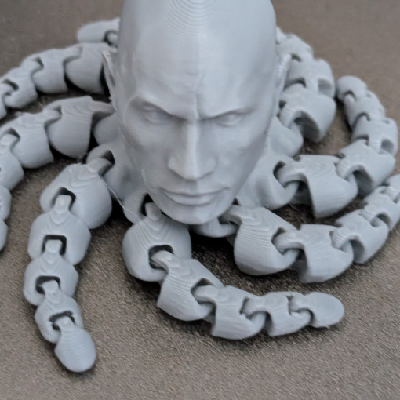So, I’m trying to print some older models from thingiverse and I have discovered that basically all the files I want to print have glaring flaws in them.
Internal free floating structures, connector pieces and holes that are the exact same size… So on and so forth…
Do I need to learn a software like CAD or Blender to fix these? I seem to be able to do some basic stuff in Orca Slicer but it honestly seems like as much of a pain to modify the parts there as it would be to use a real software.
Is there one that’s easier? I think I messed around with SketchUp once upon a time.
I am worried this feels like opening a can of worms just so that I can make a thing that already exists in a dozen forms better.
This post turned out to be a bit of a rant about what drives me to model my own designs most of the time. In short, it isn’t required, but I highly recommend it.
I’d say that most people who own 3D printers have little to no skill in modelling and are happy printing whatever they can download online. Maybe they hit a point where they want more, but until then learning modelling isn’t a useful skill for them.
Personally, I’m a designer at the end of the day. 3D modelling is a crucial tool in taking my ideas and bringing them to life in a way that can be passed to a manufacturing process and made into a physical object. 3D printing just happens to be the manufacturing tool I use most often for personal projects because it is what I have the easiest access to. If I had a machine shop, I’d use that too. When working on high volume products I’ll design for injection molding, die casting, sheet metal, compression molding, etc.
I’m not against utilizing models people have already put online that solve the problem I want, that is just efficient use of resources. But I agree, most models out there are very poor quality so I pretty rarely use downloaded models. Heck, I just re-modelled Gridfinity bins because I couldn’t find a parametrically adjustable model for SolidWorks that I was happy with (on that note, the dimensional documentation for Gridfinity is straight garbage and I’m still not sure I have it right) and those are some of the most widely available models out there.
I also absolutely despise STL and other non-parametric file formats for sharing designs. They are terrible, inefficient formats that make files very hard to edit. Most people don’t export them in high enough resolution resulting in horrible looking faceted models. The community needs to fully accept STEP as the file format of choice now that any slicer worth using can import them properly.
I prefer parametric SCAD models. Maybe because I’m more of a developer than a designer.
SCAD allows for really cool things like I did with a parametric calendar model - you just input the year and it automatically calculates the first day of the year using a clever algorithm. It also works with leap years automatically, which is less cool but still very convenient.
But still doesn’t have chamfers or fillets.
I mean, OpenSCAD has primitives which you use to create your own shapes. It does have chamfers, if you add a module for that. Or download someone else’s code.
@Krauerking my opinion is no. For many things you can find a model on line. Much of the challenge can be getting the printer to work as you wish, so modelling might not be first on the to do list.
If you happen to have any background with coding, I recommend OpenSCAD. There are a (relatively) limited set of instructions, easy to pick up if you do any other coding.
Netfabb before Autodesk fucked it will fix a lot of hanging vectors, Sketchup is just way easier to use than any CAD software I’ve every used but may or may not be able to open files included with Thingiverse downloads, depending on what was used to make them.
DM me if you need a copy of either. I’ve installed both on Linux in the past as well and have a link to some documentation on that.
It’s not great for every use case, but my ‘get this printable’ solution is Tinkercad. It’s pretty easy to use, but is correspondingly simple.
i’ve been dying to try an llm that can generate stls from natural speech
@slug @Krauerking there are some out there. Can’t say I looked to closely but I wasn’t terribly impressed.
Yes. Advise against doing what I did which is getting weirdly agile with modeling in the slicer at the cost of making cad software less desirable to learn. I finder Tinker cad pretty limiting and personally I can do more in slicer than I can with tinkercad. I do like Mattercontrol which is free, easier to use, and more powerful than tinkercad.
The time and effort you put in to learning 3D Cad will more than pay off for you in your ability to make things you need that someone else hasn’t yet made and posted online. Sure, it will be a bit of learning curve, but what are we here for but to learn and grow?
I use FreeCAD which is FOSS. There’s a great series of Youtube Videos by Mango Jelly on how to use it.
I am down to learn. It’s why I asked but I will say there is a dozen softwares and forks out there and I am not in the right space to be able to spend large amounts of time learning the deep ins and outs. And I generally don’t feel a constant need to design new pieces for myself.
But thank you for the suggestions and the video suggestions as well.
May not be a popular opinion, but if you just want to fix shit like that, you can use Microsoft 3D Builder, it’s super simple and pretty powerful.
Modifying existing meshes is difficult, especially more complex ones, I find that this makes it much easier to fix dumb shit or make simple modifications.
Oh my God the bastards at Microsoft killed the app!
I had used that before to fix files. It was great.
I can’t seem to redownload it without jumping through hoops but know this was the right answer for none coder fixes. Sigh.
Wait, you can’t downland it from their store at all anymore?
Looks like you can download and install it using this:
Paste in the product url and select retail.
Https://apps.microsoft.com/detail/9wzdncrfj3t6
It will take a little Google to see which files to DL and how to install them.
I’m going to keep a copy on my PC now that I know it’s been taken down.
Amazing. You are incredible.
Is that like their replacement for 3D paint? I used that once to add a hole to a model?
It’s insane that I feel like I can understand the rules of 3D printing just fine but need to potentially put hundreds of hours learning software to fix other models so I can do it past the easier fidget toys that seem to be designed by the modeling geniuses.
No, it’s adjacent to 3D Paint. I never really liked 3D Paint actually.
For parametric modelling, that’s super easy and you can get into it pretty quickly, but organic modelling is a whole different story and is what takes the hundreds of hours.
While I’ve messed around in Maya and 3DS Max, its so much more difficult than parametric and Modifying high poly models requires tons of ram and a beefy PC. I spent a month trying to bake a bump map onto a model so that I could 3D print it and 90% of the time the applications crashed, Maya, 3DS and Blender all crashed when trying to do it, and none of them could do it right either. I pretty much gave up on that.
Thanks that seems about right for my experiences but that seems like the info I need.
If all you have are STLs then you’re pretty limited. I use Meshmixer to do basic modifications or tweaks to STLs but it’s not super user friendly.
Yeah… Just STL files.
And I mean trying to add anything in orca slicer seems to be far worse. I got lucky with modifying a single piece in orca slicer via a million measurements and micro adjustments but it felt like pulling teeth from a shark.
IMO it’s worth the time and effort to learn the basics. You don’t need to be an elite level modeler because you’re not modeling for animation or games. I’ve had good luck with simple fixes and mods in Blender.
My experience is entirely with SLA, however, FDM might be a bit trickier.
Yeah I think people forget about print orientation and stuff like that with FDM.
I think the person said they printed with supports on but didn’t have great results and my thought is how they didn’t realize they made supports inside their part to get it to print that could have been solved with some mounting points for the bridging.
Which in theory sounds like something I could do… No animation…
But man slicer modifiers made me want to go insane and I barely managed to learn Photoshop, gimp, and the like.
But thanks. I’m noticing basically 2 camps for software and it helps at least narrow down what I’ll find support for using I guess.
Gimp and PS made no sense to me. Ive learnt $d modling over time and don’t it fairly easy.
Started with Tinkercad. Its fine for the basics. Square plus circle minis triangle etc. It dosnt have a timeline or parametric though, so small changes are pretty hard.
Mixed to fusion360. Free if you can navigate the site. Heaps of tutorials non lone and really solid to. Basically draw in 2d and extend. Draw in 2d and cut. Heaps non other use full ways to modify things too. Its parametric so you can say one side is X long. And change X and the model will scale.
Focus on the 2d shapes, fully constraining them and making them simple.Moved to Onshape. Its not got the 10active models that fusion has. And runs (surprisingly well) in browser. i can jump on any PC (work cough) and make edits. The tools (for most people) are on par with fusion and I found it more initiative.
Watch heaps of builds on fusion and you’ll get the just pretty quickly.
Tinkercad (free, closed source, in browser) is what I use. It’s very basic, but easy to learn.
So many CADs.
I grabbed FreeCAD but it made no sense to me.
Yeah abandon FreeCAD for now. It’s a powerful FOSS option, and the new v1.0 looks promising, but I second TinkerCAD to learn. It’s intuitive, and most of the principles you learn will translate fairly easily to other CAD software. Unless you’re trying to sculpt organic shapes, I’d focus off TinkerCAD
I second tinkercad for super basic parts. Need to print a knob for a radio that isn’t on thing-verse? 20min in tinkercad.
For blender basic things to learn could be plugging a hole in a part and adding a smaller or bigger one to match the screws you have on hand.
Or cutting a part in half to extend it, fill in the gap.
Tinkercad is just combining basic shapes, so there’s basically no learning curve.
Yeah I noticed that. Kinda feels like doing it in the slicer but with brighter colors.
So, FreeCAD. It’s a beautiful hot mess. There’s a 1.0 in beta right now that’s bringing some much needed changes.
FreeCAD has a lot of parallel capabilities; it has an architectural workbench for drawing buildings, a Drafting workbench for more traditional 2D drawing, the Part workbench for a weird kind of boolean approach, and the Part Design workbench for a more typical sketch-and-extrude parametric modeling workflow like Fusion360, Inventor or OnShape.
The workflow is you create a sketch and draw a 2D shape, and then extrude (FreeCAD uses the word Pad) it into 3D space, then you can draw further features on that to design the shape you want.
The basis of how it works is somewhat unintuitive at first. “Parametric” means you draw using rules. There’s a piece of software out there called OpenSCAD that is a very pure implementation of this because you “draw” by typing code in a kind of programming language. FreeCAD lets you represent rules by drawing things with the mouse. Rules like “this is a straight line. It is parallel to the X axis. It is 5cm long. The leftmost endpoint is 3cm from the X axis and 4cm from the Y axis.” There’s only one way to draw that line. Those rules may be called Constraints or Dimensions. The powerful part is you can later change one of the rules, like “Did I say 3cm from the X axis? I meant 4cm” and it’ll redraw the whole part for you. Get your head around that concept and CAD software will unlock.
The UIs are different, but the general concepts are similar for FreeCAD, OnShape and Fusion360, sometimes tutorials for one will be useful for learning the others.
Oh man I wanted to mention Ondsel but I just saw that they’ve shut down and it really bummed me out…
Damn, that’s really sad
They did? I’ve been using it
They just announced it a week or two ago, but they’re keeping the server up for “a reasonable period” to allow users to migrate. From my understanding, many of their tweaks have been integrated into 1.0 and the team all plans to continue working with FreeCAD and submitting improvements.
All of their changes will be merged to freecad 1.0 apparently outside of a few UI changes that will be add-in options.
I was kind of wondering how long that project would last.
Google’s sketchup (last free version is from 2017, but can still be found) is easy tool and still has bunch of mantained add-on’s.
Even though I have FreeCAD installed (and I thinkered in it) I use SketchUp for all my prints.
Plus in comparison to FreeCAD SketchUp has no learning curve (plus I learned some tricks from free tutorial videos Trimble uploads)I find that being able to sketch up things I need in CAD and then print them is both cool and really useful. It’s the main reason I bought a printer in the first place. Thus far I’ve tried out FreeCAD, Solid Edge, and Blender. With any modeling package, you will have to dedicate time on a regular basis to really get used to them. FreeCAD is certainly nice for the fact it’s free, just as it implies. I used it to design a few parts that were functional. It works, has some useful workbenches and add-ons. My problems were the software having bugs that caused models to break when trying to make changes, and available training info was often outdated. Siemens offers a free version of Solid Edge to makers, which is really nice, even with some of the advanced features turned off. It’s a much more polished program with great training resources. You can only export designs as stl files, but that’s fine for 3d printing. Solid Edge will slice and print, but I always import files into Orca and go from there. Blender looks really amazing for modeling, but I admit I haven’t spent enough time learning it yet. You can use it to manipulate meshes, which is useful for customizing and fixing models. I’ve used it to Frankenstein together different models for custom prints I wanted. But yeah, while you don’t have to learn to use modeling software to do prints, it opens up so many options for you to be creative. I think it’s worth while.
I’ve been reading the other comments, and while people are encouraging, their comments seem a bit too “you HAVE to learn CAD.” You definitely don’t NEED to know CAD. I made basic parts and modifications in the slicer for nearly a year after I started printing, and it worked really well. However, if you are considering learning a full CAD program, I have two pieces of advice.
First pertains to if you are working with functional parts. Then you are talking about a parametric CAD program (fusion, onshape, FreeCAD, etc.). In this case, I think it’s worth learning for you, and it’s not as hard as it seems. You say you have SketchUp experience, so I’m assuming you have decent spatial reasoning. I know someone with no tech literacy nor programming experience who learned a CAD program very well in less than a month of following tutorials in her free time. Just give it a try, and it’s a skill you’ll be happy to have.
If you are working with cosmetic parts like miniatures and helmets, then you might need to use something like Blender. Admittedly, that can be even more challenging than the other CAD programs I mentioned. However, if you spend a few hours learning some basics from YouTube, you should be able to do fundemental things like fixing holes.
Hope this helps. Good luck with your printing endeavors!













